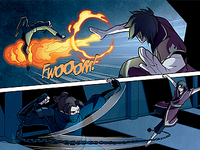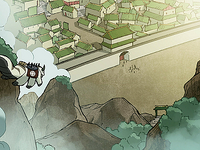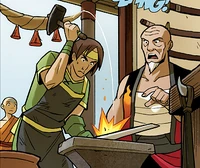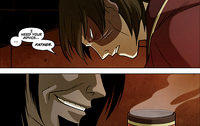| "Fire Lord Zuko has officially withdrawn his support of the Harmony Restoration Movement!" |
| — A Fire Nation soldier informing Team Avatar and recently deported colonials of Zuko's decision. |
The Promise Part One is the first installment in The Promise trilogy, a graphic novel continuation of the Avatar: The Last Airbender storyline, originally released by Dark Horse Comics in collaboration with Nickelodeon on January 25, 2012, and later released with its counterparts in Avatar: The Last Airbender—The Promise Library Edition HC on February 20, 2013.
Overview
A year after the Hundred Year War's conclusion, Aang and Zuko are working in collaboration with Earth King Kuei to remove the Fire Nation colonies from Earth Kingdom shores in the Harmony Restoration Movement. Worried that he would one day become like his father, Zuko forced Aang to make a life-changing promise to him soon after the War ended. When Zuko attempts to go against the wishes of Aang and Kuei by allowing one unusually well-integrated Fire Nation colony to remain in the Earth Kingdom, which also leads Zuko to believe that all the colonies should stay, the promise Aang made is put to the test as he attempts to keep balance between the four nations.
Synopsis
Team Avatar meets with Earth King Kuei and decides to organize the Harmony Restoration Movement, an effort with the goal of removing Fire Nation colonies from the Earth Kingdom. Afterward, the group goes to the Jasmine Dragon preceding a planned celebration for the end of the War, where Aang and Katara kiss for a short while before being interrupted by Sokka. Team Avatar subsequently takes Appa for a ride, where Zuko makes Aang promise to kill him if he ever becomes like his father.

Kori attacks Zuko, intending to kill him for his support of the Harmony Restoration Movement.
A year later, Zuko wakes up, sensing that someone is approaching with an intent to kill him. While his guards disregard his claim, they are knocked out by the assassin. Zuko begins attacking the assailant with firebending, eventually managing to defeat her. After unveiling her face, Zuko orders her to give him a reason to let her live. When the assassin, Kori, claims that her entire life has been ruined by the Harmony Restoration Movement and that her father is the mayor of Yu Dao, Zuko spares her and takes her back to the colony.
Upon arriving in Yu Dao, Zuko argues with Morishita over the benefits of the Harmony Restoration Movement. When the mayor refers to Zuko as being weaker than his father, Zuko has a flashback to his first confrontation with his father as Fire Lord. Ozai had dodged Zuko's question about his mother, instead inviting Zuko to have tea with him and accept his advice as a past Fire Lord. As Zuko left, Ozai claimed Zuko would return. The mayor calls Zuko a traitor upon Zuko's outburst against him.
Approaching the Fire Nation, Aang is consoling Mayor Nishi about returning to the Fire Nation. He claims that life will be better, while the mayor remains skeptical. After landing in the Fire Nation, an Army officer orders that the cargo ship be reloaded in light of Zuko's withdrawal of support for the Harmony Restoration Movement. Aang, Katara, and Sokka immediately leave for Yu Dao, where Zuko is staying. At the Beifong Metalbending Academy, Toph's students are looking out the window at a crisis happening in Yu Dao. Toph tells them to get back to their lessons and, after hearing Appa fly above, leaves the school to find her friends. She uses earthbending to leap onto Appa, where she is told about Yu Dao's crisis.

Team Avatar arrives at Yu Dao.
Aang is meditating, calling on Roku for help. Roku reminds Aang that he needs to keep balance and that Zuko is creating imbalance. Aang agrees but says he must talk to Zuko first. After arriving outside Yu Dao, Aang meets up with Smellerbee, informing her of the situation before taking Katara over the city walls on his glider. Once inside, the pair is attacked by guards who insist that people are only allowed to enter with Zuko's permission. Katara defeats the guards and tries to attack another who charges at Aang, but before she can, the waterbender is grabbed by Zuko, who admonishes her for attacking his "people". Aang separates the two with airbending, prompting Zuko to retaliate. After blocking the attack, Aang enters the Avatar State, intent on killing Zuko. Katara manages to calm him down, and Zuko agrees to talk.

Aang tours Yu Dao and sees Earth Kingdom and Fire Nation residents working together peacefully.
Zuko gives the couple a tour of Yu Dao, pointing out how heavily integrated the lives of the citizens are. He also explains how he found out that the city's mayor married an earthbender and had a daughter who was also an earthbender. Zuko reminds Aang that the Fire Nation put effort into building Yu Dao into its current state and that they deserve to stay. Katara proposes a conversation with Kuei concerning the matter, to which the Avatar and Fire Lord both agree. Aang and Katara leave Yu Dao, landing outside to speak with his friends.
While Aang and Katara are inside Yu Dao, Sokka and Toph remain outside with the protesters. Sokka suggests that the group calm down and is hit by a small rock. Toph raises herself into the air on an earth column and forces silence upon the crowd. After flying over the walls, Aang explains the situation to Sokka, Toph, and Smellerbee. Smellerbee is angry that Zuko is not leaving and gives Aang an ultimatum. She says that she will lead the Freedom Fighters in a revolt if the Fire Nation has not left within three days. After leaving, Aang thanks Katara for helping him out of the Avatar State. Katara accepts his thanks by embracing him, prompting Sokka to make another reference to "oogies." Toph explains the concept to Katara by licking her hand, prompting a "grossed-out" response.

At the Fire Nation Capital, Zuko returns to his palace where Mai awaits. She attempts to console him, citing his lack of sleep. She brings in the Kyoshi Warriors as his new set of guards to protect him from assassins. That night, Zuko wakes up again. When he checks outside, Suki and Ty Lee claim that nothing is wrong. Zuko leaves to get a drink, making tea and taking it to the Capital City Prison. He kneels before Ozai's prison cell, asking for advice.
Publication
Since the conclusion of the original series in July 2008, fans of Avatar: The Last Airbender had demanded a more satisfying denouement in relation to the fates of the main characters. In late 2010, Samantha Robertson, an editor at Dark Horse Comics at the time, approached comic author Gene Luen Yang, who was best known for his American-Born Chinese series. After some conversations with her and the creators of Avatar, Michael Dante DiMartino and Bryan Konietzko, Yang was contracted to write three graphic novels to serve as a direct sequel to the original series.[1] Yang's approach to the writing of The Promise was purported to be "purist",[2] and he collaborated closely with DiMartino and Konietzko for this series.
Reception
The Promise Part One has received mostly positive reviews, with Convention Scene praising Yang's portrayal of the characters. Convention Scene also praised Gurihiru Studio's artwork, stating that it did justice to the series.[3] The Seattle Post-Intelligencer called the graphic novel an "enjoyable read even if you are not well versed in the story's universe."[4]
Sales of The Promise have been outstanding, excelling "in a place comics don't usually: Bookscan, which tracks sales only in bookstores and other not-a-comic-shop locations". Within two weeks, it had claimed the top spot on the Bookscan charts.[5]
Production notes
Transcript
- Main article: Transcript:The Promise Part One
Translations
- Main article: Writing in the World of Avatar
Series continuity
- This story begins immediately after the last episode of the original series, "Sozin's Comet, Part 4: Avatar Aang".
Goofs
- On the first panel of page nine, Katara's dress is shown to be much longer than it was in season three. This is corrected on the next page.
- When Zuko visits Ozai in jail, a line from the original series is missing.
- On the lower panel of page 33, Toph is shown running toward the left of the Beifong Metalbending Academy (reader-side), but when she reunites with her friends on page thirty-five, they are shown looking at the right side of the academy instead of the left.
- In one panel on page 71, the robing under Mai's dress is pink, but on the next page, the robing is red.
- On page nine, when Aang shows the world map, his sleeve is missing.
- On page 70, Aang's airbending tattoos on his arm are missing.
- When Aang says "Flameo, hotman!" it is spelled "Flamio" instead.
- On the cover, the band holding Katara's topknot is red, but for the rest of the comic, it is blue.
- Mai's eyes are yellow instead of their normal purplish-gray.
Trivia
- The main portion of the comic, as well as most of parts two and three, takes place in the "modern city" of Yu Dao, consisting of a conglomeration of different cultures, namely Fire Nation and Earth Kingdom cultures. This contrasts with the unicultural status of each of the four nations which held sway during the events of the series.
Library Edition reveals
The Promise Library Edition compiles all three parts of The Promise trilogy as well as interjects trivia- and production-based notes in the sidebar of many pages. These notes were written by Gene Yang and the Gurihiru team. The following are notable points from the Library Edition that pertain to The Promise Part One's early production phase and trivialities as attested by the aforementioned crew members.
- Gene Yang (author-perspective, storytelling trivia):
- The Harmony Restoration Movement took inspiration from the turbulent reform era of late nineteenth- and early twentieth-century China, including the Self-Strengthening and May the Fourth Movements. Yang considered the Earth Kingdom to be "in a position similar to that of early 1800s China" after the War. (p. 12)
- The scene in which Team Avatar is celebrating the War's end by watching a fireworks show on Appa is meant to represent "partying on grad night", emulating the original series' references to American youth milestones like the "high school house party" in "The Beach" and Aang's anxiety over an upcoming "final exam" of sorts in "Nightmares and Daydreams" (p. 15).
- The Promise intends to bring the concept of consent into the common Avatar trope of "is it right to murder?" Buddhism, from which Air Nomad culture takes great inspiration, counts "killing with the victim's consent" as "voluntary euthanasia" according to Yang. So, would Aang be justified in killing Zuko if the latter asked for such treatment long beforehand? Furthermore, on top of Aang's identities as an airbender (murder cannot be tolerated) and as the Avatar (murder is justified to keep balance) is his role as a friend to Zuko. The conflict between these three separate ideologies is grappled with throughout the trilogy. (pp. 16–17)
- Yang originally included Jet as a protester alongside Smellerbee, Longshot, and Sneers, having believed the character's supposed death to have been ambiguous enough for him to still be alive. However, this draft idea was scrapped when Yang was informed that Jet was, in fact, deceased. (p. 42)
- It took Yang some thought to choose "sweetie" as Aang and Katara's pet name for one another (p. 44).
- Every Chinese character on page 60 (62 in The Promise Library Edition) was contributed by Yang's mother, who had told him in his youth to develop his Chinese signage lest he regret it later (p. 62).
- Kori Morishita's family is meant to foreshadow the diversely mixed families of The Legend of Korra (p. 65).
- Yang consulted with DiMartino, Konietzko, Dark Horse, and Nickelodeon greatly in concern to Zuko and Ozai's relationship development in The Promise (p. 78).
- Gurihiru (stylistic and artistic trivia):
- The opening sequence of Avatar: The Last Airbender was watched numerous times by Gurihiru in order to adequately recreate it during the novel's introduction (p. 7).
- It was difficult to devise a color scheme in Yu Dao that would adequately portray the meld of two cultures (p. 24).
- Flashback scenes were colored by first employing the shades that would normally be used in any other instance, followed by "limiting the hues" in a later phase of production (p. 28).
- Page 33 of Part 1 (35 in The Promise Library Edition), panel one, was conceived as a high-angle shot in layouts, but the perspective was changed in order to clearly show Toph's face (p. 35).
- Drawing the conversations between Aang and Roku was simple since there was no background to make the scenes complicated (p. 40).
- The Gurihiru team, with only a single episode for reference, thought by Sneers' design reference that he was female, which is why he was drawn with feminine features (p. 42).
- Yu Dao's architectural basis was majorly urban China and "a touch of Japanese design" (p. 62).
- Waterbending was a "significant challenge" for Gurihiru, who had trouble with "capturing a sense of fluidity and motion in a static illustration" (p. 52).
- The afternoon scene on page 69 (71 in The Promise Library Edition) was mistakenly painted as a sunset in early stages, but this was corrected when Gurihiru was informed of the error (p. 71).
- Ozai and Zuko's nighttime chats were illustrated without "complicated panel layouts" in order to preserve a feeling of quietude throughout the scenes (p. 77).
References
- ↑ "Exclusive: Interview with Author of Season 4 Avatar The Last Airbender Comics, Gene Yang". Avatar The Last Airbender Online. Retrieved on November 9, 2011.
- ↑ Bynum, Aaron H. (August 31, 2011). "New 'AVATAR' Comics in 2012". Animation Insider. Retrieved on November 9, 2011.
- ↑ Solan, Colin (December 27, 2011). "ConScene Review: ATLA: The Promise". Convention Scene. Retrieved on December 28, 2011.
- ↑ Jones, Michael (December 27, 2011). "Graphic Novel Review: Avatar: The Last Airbender Volume 1 The Promise Part One TPB - Dark Horse Comics". Seattle Post-Intelligencer. Retrieved on December 28, 2011.
- ↑ "Avatar: The Promise Tops Charts" (February 16, 2012). Retrieved on April 23, 2012.